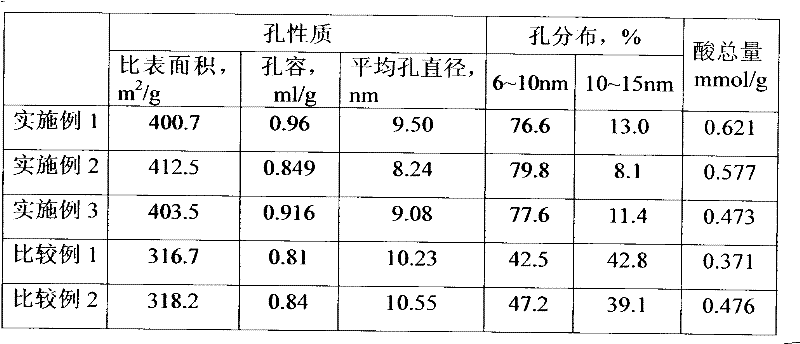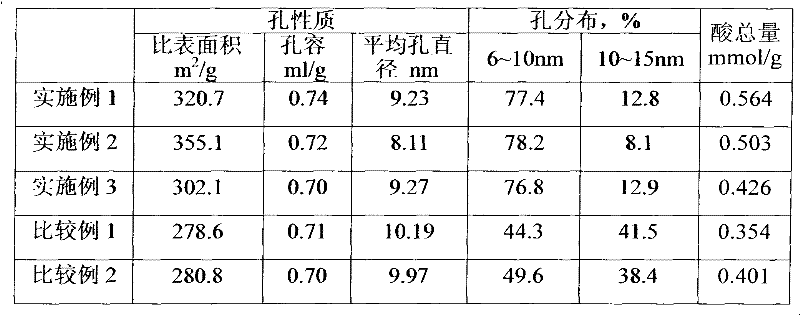Method for preparing zirconia-alumina composite oxide carrier
A composite oxide and alumina technology, applied in catalyst carriers, chemical instruments and methods, chemical/physical processes, etc., can solve the problems of rapid precipitation of zirconia, wide particle size distribution, and different particle sizes, and achieve easy vulcanization. , the effect of narrow pore size distribution and simple production process
- Summary
- Abstract
- Description
- Claims
- Application Information
AI Technical Summary
Problems solved by technology
Method used
Image
Examples
Embodiment 1
[0032] Mix 1000ml 2mol / L aluminum nitrate with 20ml silica gel (containing SiO 2 25wt%) and mixed, adding ammonia water to adjust the pH to 7, and reacting at 80° C. to obtain sol A. 1mol / l ZrCl 4 The solution and dilute ammonia water were added dropwise to a beaker containing ethanol and deionized water. The ethanol accounted for 15v% of the water. The pH value was controlled to be 6.5, and the reaction temperature was 45°C to obtain sol B. Mix sol B and sol A, stir for 2 hours, heat up to 50°C, age for 2 hours, add 200 ml of ethanol, filter with suction, wash 3 times with deionized water, dry at 120°C for 3 hours and pulverize to obtain a composite oxide dry glue. After calcination at 600° C. for 3 hours, a composite oxide was obtained, in which the content of zirconia was 60 wt % and the content of silicon oxide was 1.5 wt %. The main properties are listed in Table 1.
[0033] Take 123g of composite oxide dry glue, 13.9g of SB powder, add 3g of succulent powder, 5ml of di...
Embodiment 2
[0035] Mix 100ml 2mol / L aluminum nitrate with 20ml silica gel (containing SiO 2 25wt%) and mixed, adding ammonia water to adjust the pH to 7.0, and reacting at 60° C. to obtain sol A. Under stirring conditions, oxalic acid (0.1 mol / l) was slowly dropped into 0.1 mol / l zirconium nitrate to make pH=5.5, and after stirring for 10 minutes, it was put into a three-necked flask and heated to 95°C, and refluxed at a constant temperature for 2 Sol B was obtained within hours. Dilute sol B twice with distilled water, mix with sol A, stir for 2 hours, heat up to 50°C, age for 2 hours, add 200 ml of ethanol, filter with suction, wash with deionized water 3 times, dry at 120°C for 3 hours and pulverize. The composite oxide dry glue was calcined at 600° C. for 3 hours to obtain a composite oxide, wherein the content of zirconium oxide was 30 wt %, and the content of silicon oxide was 2 wt %. The main properties are listed in Table 1.
[0036] Take 114g of composite oxide dry glue, 27.8g ...
Embodiment 3
[0038] 1 mol / L aluminum sulfate and 1 mol / L sodium aluminate were mixed in co-current flow, the pH value was adjusted to 7.0, and sol A was obtained by reacting at 50°C. The rest are the same as in Example 1. The content of zirconia in the composite oxide is 10wt%, and its main properties are listed in Table 1.
[0039] Take 132g of composite oxide dry glue and 13.9g of SB powder, add 3g of succulent powder, 5ml of dilute nitric acid, knead, extrude, dry at 120 °C for 3 hours, and bake at 600 °C for 3 hours to obtain a composite oxide carrier. The properties are listed in Table 2.
PUM
| Property | Measurement | Unit |
|---|---|---|
| Density | aaaaa | aaaaa |
| Density | aaaaa | aaaaa |
Abstract
Description
Claims
Application Information
 Login to View More
Login to View More - R&D
- Intellectual Property
- Life Sciences
- Materials
- Tech Scout
- Unparalleled Data Quality
- Higher Quality Content
- 60% Fewer Hallucinations
Browse by: Latest US Patents, China's latest patents, Technical Efficacy Thesaurus, Application Domain, Technology Topic, Popular Technical Reports.
© 2025 PatSnap. All rights reserved.Legal|Privacy policy|Modern Slavery Act Transparency Statement|Sitemap|About US| Contact US: help@patsnap.com


